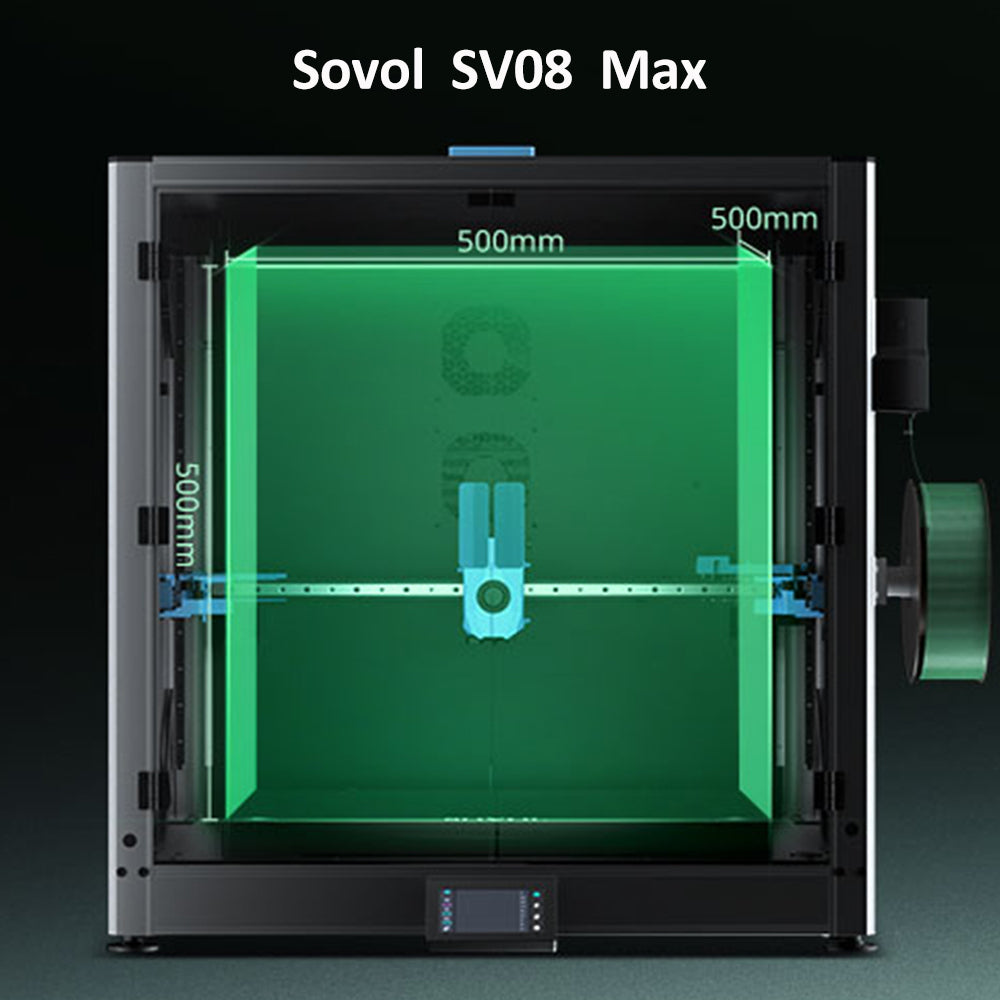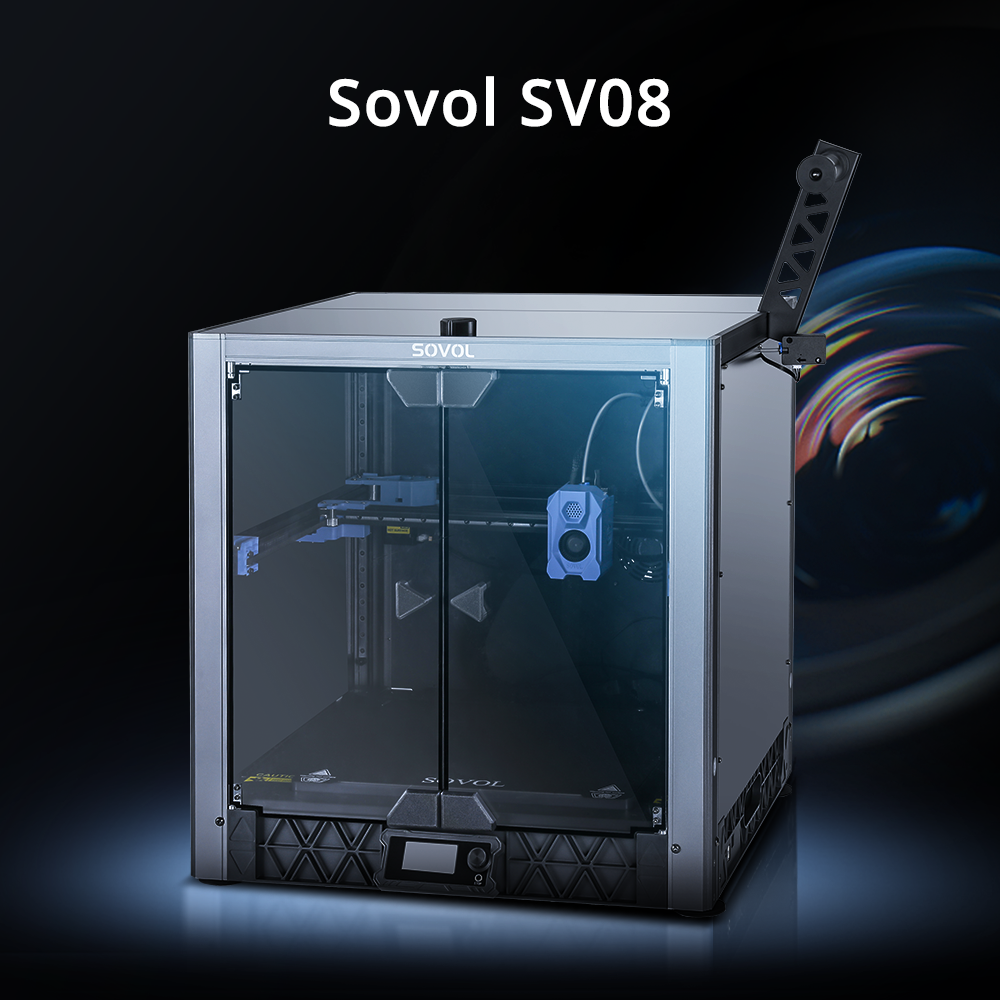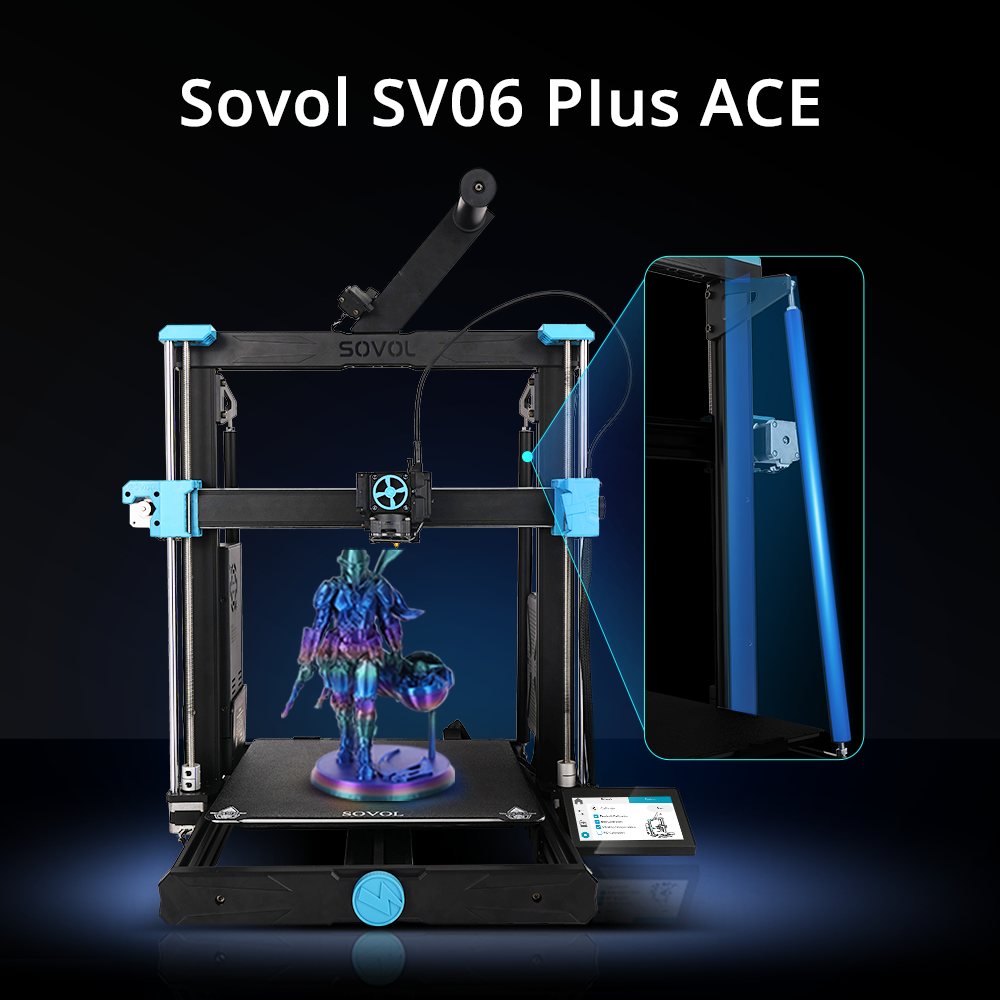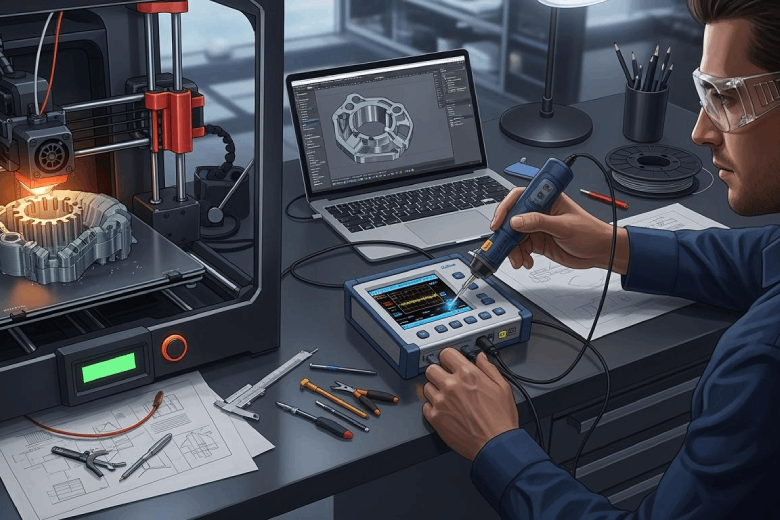You want the highest quality and reliability from your 3d printing projects. The eddy current scanning kit gives you a major advantage. With eddy current scanning, you achieve contactless bed leveling and precise mesh generation. The Sovol SV08 MAX 3d printer, for example, uses this technology to level a 500×500 mm bed in only 80 seconds. You get improved first-layer adhesion and better overall print quality. Eddy current scanning detects even the smallest surface changes, so you spot defects early. This leads to faster, more accurate detection and printing compared to traditional methods.
- SV08 Max's eddy current scanning system levels a 500×500 mm bed in just 80 seconds.
- This technology detects even the smallest surface changes, enhancing bed leveling speed and accuracy.
- Improved first-layer adhesion and overall print quality are direct benefits of this advanced system.
Key Takeaways
- Eddy current scanning kits enable fast bed leveling, completing a 500×500 mm bed in just 80 seconds, which saves time and improves print quality.
- This technology detects tiny surface changes without contact, enhancing accuracy and reducing the risk of defects in your 3D prints.
- The non-contact nature of eddy current scanning prevents wear on printer components, extending the lifespan of your equipment.
- Using an eddy current scanning kit leads to better first-layer adhesion, resulting in smoother surfaces and fewer print failures.
- Consider adding an eddy current scanning kit to your setup for improved reliability, especially if you work with large or complex 3D printing projects.
Eddy current scanning kit overview
What is an eddy current scanning kit?
You use an eddy current scanning kit to improve the accuracy and reliability of your 3d printing projects. This kit relies on eddy current testing, a method that uses electromagnetic induction to inspect surfaces without touching them. When you set up the kit, you find several important components working together:
- The eddy current scanning system uses magnets to detect tiny differences in the bed surface.
- Electromagnetic fields help you identify flaws or irregularities without contact.
- A coil with alternating current creates a magnetic field, which induces eddy currents in conductive surfaces.
- The scanning area covers large beds, like the Sovol SV08 Max’s 500x500mm platform, for high-precision inspection.
- Z-axis offset adjustment keeps the nozzle at the right height during printing.
- You can use printed flexible eca probes and printed eca probe designs for more flexible inspection applications.
- Eddy current array probes allow you to scan wide areas quickly.
This technology lets you inspect the bed and printed objects with high sensitivity. You avoid wear and tear because the probes never touch the surface.
Core function in 3D printing
You benefit from the eddy current scanning kit because it integrates smoothly with your 3d printer’s hardware and software. The kit works with models like the OLSK Small 3D Printer V3, which uses an eddy current scanning system for auto-calibration before each print. You save time since calibration finishes in under five minutes.
|
Feature |
Description |
|---|---|
|
Printer Model |
OLSK Small 3D Printer V3 |
|
Integration |
Eddy Current Surface Scanner integrated for auto-calibration before prints |
|
Calibration Time |
Auto-calibrates in under 5 minutes |
You use eddy current scanning to create a mesh of the bed surface. This mesh guides nozzle adjustments and improves first-layer adhesion. The printed flexible eca probes and printed eca probe designs help you adapt to different inspection applications. You achieve better print quality and reduce the risk of defects. The eddy current scanning kit makes your 3d printing process faster, more precise, and more reliable.
Bed leveling and mesh generation in 3D printing
Rapid bed scanning with eddy current probes
You want your 3d prints to start on a perfectly level surface. The eddy current scanning kit helps you achieve this by using advanced probes that scan the bed quickly and accurately. These probes do not touch the bed, so you avoid any risk of scratching or wearing out your equipment. You can scan a large 3d printer bed, like a 500mm platform, in about 80 seconds. This speed is much faster than traditional methods.
- Contactless measurement means you never worry about probe drag or mechanical wear.
- High speed scanning lets you finish bed checks in under two minutes.
- The probes work well even on heated beds, unlike some other sensors.
- You get the same results every time, which helps your first layer stick better.
You can see the difference in performance when you look at the numbers. The probes offer a resolution of 0.5 microns and a sampling rate of 1 kHz. You can scan at speeds up to 500 mm per second. This level of detail means you catch even the smallest bumps or dips before you start printing.
|
Performance Metric |
Description |
|---|---|
|
Faster inspection time |
Scans in minutes, faster than traditional methods. |
|
Larger area coverage |
Inspects wide areas in one pass with multiple coils. |
|
Increased accuracy |
High reliability and defect detection probability. |
|
Sensitivity to surface defects |
Detects defects as small as 0.5 mm. |
|
Quick and simple |
Ideal for regular, high-speed inspections. |
Dynamic mesh creation for nozzle adjustment
After the rapid scan, your 3d printer uses the data to create a detailed mesh of the bed surface. This mesh guides the nozzle as it moves, adjusting its height in real time. You get a smooth first layer, even if the bed has tiny imperfections. The eddy current scanning system updates this mesh before every print, so you always start with the best possible setup.
You benefit from the non-contact nature of eddy current scanning. The probes never touch the bed, so there is no mechanical wear on your printer or the probe itself. This method allows you to detect small surface changes without causing damage. You can run frequent scans without worrying about equipment lifespan.
- The non-contact method prevents probe drag, which is a common issue with mechanical probes.
- You eliminate mechanical wear on both the probe and the printer components.
- The technology allows for precise detection of bed surface variations without physical contact.
You will notice that your 3d printing projects become more reliable. The mesh generation process is quick and accurate, so you spend less time troubleshooting and more time printing. The eddy current scanning kit gives you a clear advantage in both speed and precision.
Print quality and defect detection
Non-contact defect identification
You want your 3d prints to be free from hidden flaws. The eddy current scanning kit helps you achieve this by using advanced probes for non-contact inspection. These probes scan the surface and subsurface of your 3d printed objects, identifying microscopic defects that traditional methods often miss. You avoid mechanical wear because the probes never touch the object, which means your printer components last longer.
Tip: Non-contact inspection with eddy current scanning eliminates the risk of mechanical wear, so your 3d printer stays in top condition for more prints.
You can detect a wide range of surface flaws and subsurface issues. The eddy current scanning system identifies notches as small as 0.07 mm wide and blind holes with radii from 0.17 mm to 0.3 mm. You use absolute probes to find cracks and incomplete fusion holes, while reflection probes excel at detection of small cracks and tiny blind holes. This level of sensitivity means you catch surface-breaking defects before they affect your final product.
- Detect notches as small as 0.07 mm wide and 25 mm long
- Identify blind holes with radii from 0.17 mm to 0.3 mm
- Use absolute probes for cracks and incomplete fusion holes
- Use reflection probes for small diameter blind holes
You rely on eddy current scanning for consistent and reliable inspection. You spot surface flaws early, which helps you maintain high standards in your 3d printing projects.
Improving print reliability
You want every 3d print to meet your expectations for quality and durability. The eddy current scanning system automatically levels the bed and detects minor surface changes, ensuring a perfect first layer. You maintain positional deviation at less than or equal to 0.02 mm, which boosts print accuracy. The rigid printer frame supports design integrity, and you see fewer ringing artifacts, with reductions up to 92%. Your prints have smoother surfaces and better adhesion.
|
Reliability Feature |
Benefit to Your 3D Printing Workflow |
|---|---|
|
Automatic bed leveling |
Ensures perfect first layer and high-quality prints |
|
High positional accuracy |
|
|
Rigid frame construction |
Preserves design integrity |
|
Fewer ringing artifacts |
Smoother surface finishes |
|
Fast bed scanning |
80 seconds for consistent print quality |
You spend less time on manual adjustments and troubleshooting. The eddy current scanning kit completes a bed scan in just 80 seconds, so you start each print with confidence. You achieve better first-layer adhesion and consistent results, even on large or complex 3d printing projects.
You use eddy current scanning to detect surface flaws and maintain print reliability. You benefit from advanced detection of small cracks and other defects, which helps you deliver high-quality 3d prints every time.
Applications and relevance
Industrial and large-format 3D printing
You see the eddy current scanning kit play a vital role in industrial and large-format 3d printing. When you work with large printers like the Sovol SV08 Max, you need high precision for strong machine parts, automotive components, and even airplane pieces. The large build platform demands accurate bed leveling, which the eddy current scanning system provides. You benefit from fast prototyping in schools and research labs, where quick project setups help students and engineers learn and innovate. Artists and designers also use this technology for complex geometry inspections, creating detailed sculptures and models with fewer vibrations and better surface finishes.
- Industrial parts: Strong components for machines, cars, and airplanes
- Complex designs: Detailed sculptures and models for artists and designers
- Fast prototyping: Quick setups for educational and engineering projects
Eddy current scanning kits offer high-speed scanning and precise detection of surface defects as small as 0.5 mm. The no-touch design of the probes reduces maintenance, making the system user-friendly for all skill levels.
Hobbyist and small-scale printing
You may wonder if you need eddy current scanning for smaller 3d printers. Many hobbyists find value in the technology, especially when printing models with complex geometry inspections or fine details. The probes help you achieve consistent first layers and reduce print failures. However, for basic projects or small build volumes, traditional leveling methods may be enough. You can still use eddy current scanning to improve reliability and reduce manual adjustments, but the benefits become most noticeable with larger or more intricate prints.
Is the eddy current scanning kit essential?
You decide if the eddy current scanning kit is essential based on your 3d printing needs. For large-format FDM printers, such as the Sovol SV08 Max with its 500×500×500mm build volume, the kit becomes necessary. You use it for full-size cosplay props, industrial jigs, architectural models, and multi-part batch runs. These applications require precise bed leveling and reliable inspection. For smaller or less demanding projects, the kit remains optional. You weigh the advantages of advanced detection and consistent results against your project size and complexity.
Tip: If you often print large objects or work with complex geometry inspections, you gain the most from an eddy current scanning kit. For simple or occasional prints, you may choose traditional methods.
You see how the eddy current scanning system transforms your 3d printing experience. You achieve faster bed leveling, precise mesh generation, and early defect detection. You avoid mechanical wear because the probes never touch the surface. You get smoother first layers and more reliable prints. If you want to improve your 3d projects, consider adding this technology to your setup.
Tip: Start by checking if your printer supports eddy current scanning kits. You can upgrade for better print quality and fewer failures.
- Faster bed leveling
- Accurate mesh creation
- Early defect detection
- Longer equipment lifespan
FAQ
How does an eddy current scanning kit improve bed leveling?
You use the kit to scan the bed without touching it. The system detects tiny bumps or dips. You get a more accurate mesh for nozzle adjustment. Your first layer sticks better, and you avoid print failures.
Can you use eddy current scanning kits on any 3D printer?
You need a printer with a metal bed and compatible firmware. Some printers support upgrades. You should check your model’s specifications before buying a kit.
What types of defects can the kit detect?
You spot surface cracks, tiny holes, and incomplete fusion spots. The probes find defects as small as 0.07 mm. You catch problems early and improve print quality.
Does eddy current scanning wear out printer parts?
You avoid mechanical wear because the probes never touch the bed or printed object. Your printer lasts longer, and you spend less on repairs.
Is the scanning process difficult to set up?
You follow simple steps to install the kit. Most systems offer clear instructions. You can finish setup in minutes and start scanning right away.







